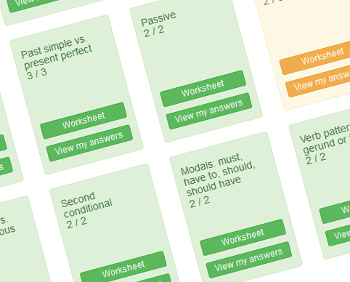Passive
Introduction
The passive voice is most commonly used for:- formal or academic writing; essays, reports, articles
- news: headlines, reporting.
- The fire was started by Robin.
- My car was stolen last night.
Form
We make the passive voice with:"be" + past participle of the main verb.
The present simple passive - examples:
| object | Verb "be" | Main verb | Complement | Subject |
|---|---|---|---|---|
| The experiment |
is
isn't is not |
carried out | every week | by scientists at the university. |
| The experiments |
are
aren't are not |
carried out | every week. |
| Verb "be" | object | Main verb | Complement | Subject |
|---|---|---|---|---|
| Are | the experiments | carried out | every week? |
The past simple passive - examples:
| object | Verb "be" | Main verb | Complement | Subject |
|---|---|---|---|---|
| The experiment |
was
wasn't was not |
carried out | every week | by scientists at the university. |
| The experiments |
were
weren't were not |
carried out | every week. |
| Verb "be" | object | Main verb | Complement | Subject |
|---|---|---|---|---|
| Were | the experiments | carried out | every week? |
The passive voice can be used in any tense:
|
Object (receives the action) |
Verb "be" (various tenses) |
Main verb (past participle) |
|---|---|---|
| The dogs | are | fed. |
| are being | ||
| were | ||
| were being | ||
| are going to be | ||
| will be | ||
| have been | ||
| will be being | ||
| have been being | ||
| had been |
In the examples above we do not know who is feeding the dogs. It is not important. What is important is that the dogs are receiving food.
If we want to include the person or thing performing the action, we can use the preposition "by":
- The dogs are being fed by a charity worker.
Practice
Complete the sentences with the correct past simple passive form of the verb in brackets:
.Further practice
.Further language points
We can employ the passive voice when we do not want to say who or what performed the action:- "I’m sorry but your vase was broken."
- "My homework was lost."
- "The accounts have been messed up."
Modal verbs can be used in the passive voice:
Present
Active – The staff should make the beds every day.
Passive – The beds should be made every day.
Past
Active – The staff should have made the beds every day.
Passive – The beds should have been made every day.
Advanced language point
Further examples of the passive voice:- future perfect –
The dogs will have been fed. - future perfect continuous –
The dogs will have been being fed. - past perfect continuous –
The dogs had been being fed.
Whilst grammatically correct, the perfect continuous tenses are not usually used in the passive voice. The situation does not usually arise and they sound rather awkward.
Create a free Getting Started account
Related links
The following exercises include use of this grammar structure:
You might also be interested in:
You might also be interested in:
Beginner
- Past simple
- Past continuous
- Present simple
- Present continuous (present)
- Present perfect
- 'Going to' and 'will'
- Present continuous (future)
- Imperatives
- To be
- Pronouns: subject, object
- Pronouns: relative
- Adjectives and pronouns: possessive
- Adjectives and pronouns: demonstrative
- Basic adjective word order
- WH questions (interrogative pronouns)
- Articles: a, an, the
- Prepositions: time and place
- There is/ there are and quantifiers
- Conjunctions and, or, but
- Comparatives / superlatives (than)
- Zero conditional (if)
- First conditional (if)
- Modals: can/can't, could, will, shall
- Verb patterns
- Sequence adverbs
Intermediate
- Past perfect
- Past simple vs. present perfect
- Past simple vs. past continuous
- Present perfect continuous
- Future simple
- Future continuous
- Passive
- Indirect speech
- Used to/would
- Second conditional
- Third conditional
- Relative clauses
- Reflexive pronouns
- Modals: must, have to, should, should have
- Verb patterns: gerund or infinitive
- Adverbs of degree
- Adjective order
- Adjectives: ed or ing
Grammar
Quickly identify and focus on grammar issues:
- Grammar worksheets and test
- Scenario-based grammar exercises
- Grammar additional practice questions
- Verb conjugation practice
- Conditionals practice
Improve your grammar
Vocabulary
Vocabulary exercises:Expand your vocabulary using our three vocabulary trainers:Practice your spelling using our three spelling tests:Practice vocabulary relating to graphs and charts:
Learn vocabulary
Dictation exercises
Practice your listening skills and spelling using our dictation exercises:
- Scenario-based dictation exercises - general English
- Scenario-based dictation exercises - business English
- Dictation: focus on grammar
- Numbers
Complete dictation exercises
Video lessons
Focus on specific areas of business English using our video lessons:
Take a video lesson





